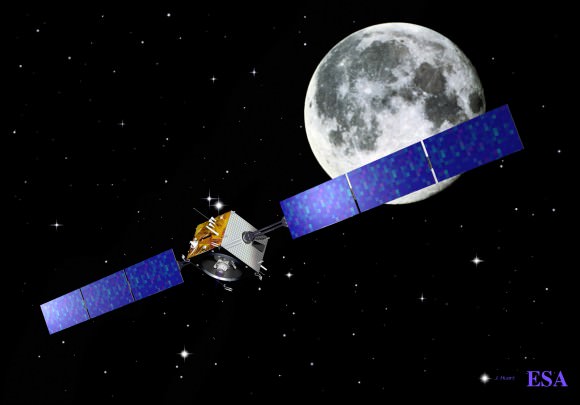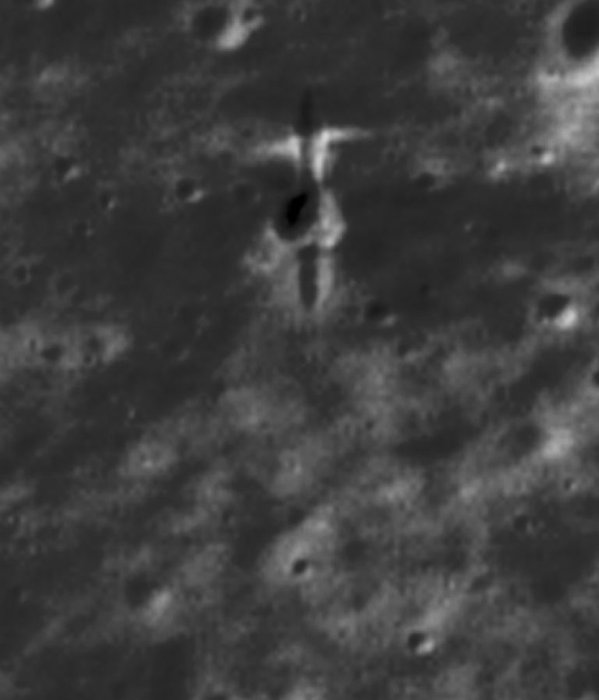In 2003, the European Space Agency (ESA) launched the Small Missions for Advanced Research in Technology-1 (SMART-1) lunar orbiter. After taking 13 months to reach the Moon using a Solar Electric Propulsion (SEP) system, the orbiter then spent the next three years studying the lunar surface. Then, on September 3rd, 2006, the mission came to an end as the spacecraft was deliberately crashed onto the lunar surface.
While the bright flash that this created was captured by observers using the Canada-France-Hawaii Telescope in Hawaii, no other spacecraft were in orbit at the time to witness it. As a result, it has been impossible for over a decade to determine precisely where SMART-1 went down. But thanks to images captured last year by NASA’s Lunar Reconnaissance Orbiter (LRO), the final resting place of SMART-1 is now known.
At the time of its impact, scientists had been able to use orbit tracking, Earth-based simulations, and observations of the bright impact flash to estimate the location of the landing site. But thanks to the images obtained by the LRO, we now have the precise coordinates of where the spacecraft impacted and bounced on the lunar surface – 34.262° south by 46.193° west.

The field of view in the LRO image (at top) is 50 meters (164 ft) wide with north pointing up and solar illumination coming from the west. When the SMART-1 orbiter touched down, it was traveling from north to south. As you can see from the image, the orbiter’s impact carved out a long gash in the lunar surface, measuring four-meters wide and 20-meters long.
The orbiter cut across a small crater as it skidded and grazed along and also sent lunar soil outwards. This created brighter patches of material on either side of the crater and left a path of debris and obliquely-ejected dust several to tens of kilometers in front of where it stopped.
In addition to surveying and photographing the Moon’s surface, the SMART-1 orbiter was also tasked with searching for evidence of lunar water ice. The SMART-1 mission also served as a testbed for a form of ion propulsion known as Solar Electric Propulsion (SEP). This system relies on electrical energy harvested from solar panels to power a Hall-effect thrusters, where electrical fields are used to ionize and accelerate propellant to generate thrust.
Compared to conventional rockets, this form of propulsion is extremely fuel-efficient. Only 82 kg of xenon propellant was used to propel SMART-1 to the Moon, while only 1 kg of propellant provided a delta-v of 45 m/s. However, the technology was still in its infancy, and the mission took 13 months to reach the Moon. For comparison, the Apollo missions took about 8 to 12 days to reach the lunar surface and return to Earth.

Nevertheless, this first test of a solar-powered Hall Effect thruster proved successful, and a variant of this technology was used by NASA’s Dawn spacecraft to explore Ceres and Vesta. This form of propulsion will also be used on the join ESA-JAXA BepiColombo mission which scheduled to launch in October. Consisting of two orbiters – the the Mercury Planetary Orbiter (MPO) and the Mercury Magnetospheric Orbiter (MMO) – this mission will map the planet and study its composition, geophysics, atmosphere, magnetosphere and geological history, effectively providing the best understanding of Mercury to date.
To top it all off, the SMART-1 mission was also the first ESA mission to reach the lunar surface. In the coming decades, the ESA plans to conduct crewed missions to the lunar surface, culminating in the creation of an international lunar village – an outpost that would act as a sort of successor to the International Space Station (ISS), where astronauts would spend extended periods conducting vital research. When it comes time to build this station, knowledge of the lunar surface and the location of water ice will prove essential.
In the end, SMART-1 contributed a great deal to European space exploration and obtained information vital to future exploration efforts. It seems only fitting that its final resting would be discovered then, since it provides the opportunity to reflect on and honor the mission’s many accomplishments. So rest in peace, SMART-1, and know that the work you helped to pioneer is leading to some major breakthroughs in lunar and deep space exploration!
Further Reading: ESA


Nice research, i hope they ll find SMART-1 rover!